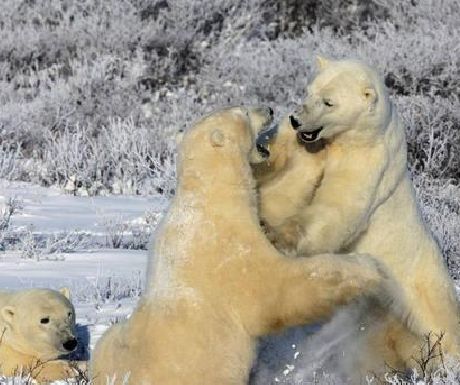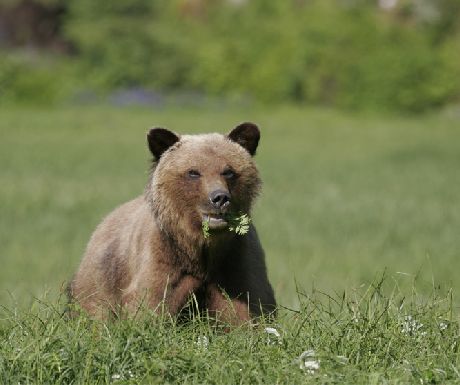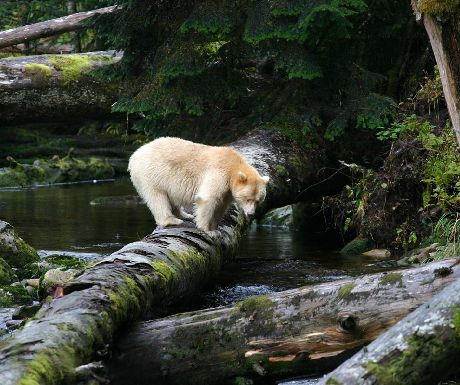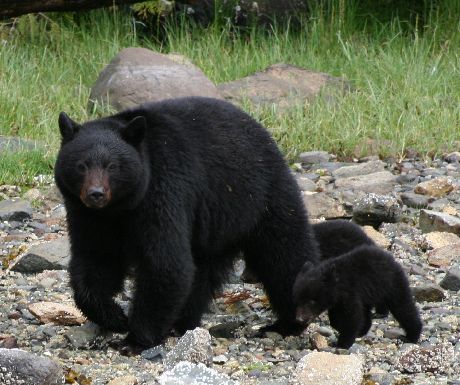Luxury comes in many forms; sometimes it is in 1000 thread count bed sheets, sometimes in the magic of seeing a bear in his natural habitat. Three species of bear call Canada home; the polar bear, king of the Arctic, the grizzly with his hump and long claws and the black bear who is the most common in North America. Confusingly the black bear comes in all sorts of colours including white; also known as the spirit bear or kermode bear, hence the 4 bears of the title.
Polar bear
The polar bear is seen most easily from Churchill in northern Manitoba. The best time is from late October to mid November but they can also be found in August at which time you can also swim and kayak among the canary of the seas, the white beluga whale. The accommodation in Churchill is fairly standard but outside the town are two lodges where Mike and Jeanne Reimer have created something very special.

Dymond Lake Lodge and Seal River Lodge are both only accessible by light aircraft from Churchill; there is no road access. The lodgings are fairly simple but the food is exceptional and the surroundings unbelievable. Jeanne grew up in the north, her parents founded Webber’s lodges of which Dymond Lake Lodge is one and what she does not know about the hospitality industry and making guests welcome and comfortable is not worth knowing. She is also a superlative cook; if you go, do buy one of her cook books. Husband Mike is known as the “Ultimate Outdoorsman” and likes nothing better than guiding their guests and sharing his knowledge of this extraordinary landscape and its inhabitants.
Spend a week at either lodge and you will see polar bears in a very personal way; there will be no sitting around all day in a tundra buggy. Instead you will go out on foot with your guides and look for the bears. Indeed, sometimes there is no need to walk anywhere. Behind each lodge is a large fenced in area and the bears will often come to you. It is a remarkable experience to see these enormous animals from ground level and the photographs you will return with will be amazing. Some of the trips have a professional photographer present to help you photograph the bears as exposures can be very tricky photographing white on white and some expert help can be helpful.
Grizzly bear
The grizzly bear is technically known as Ursos arctos or brown bear and lives in a vast area stretching from Russia through Asia, Europe and into North America going as far south as Wyoming.

One of the densest populations live in the Great Bear Rainforest of British Columbia and it is here that you will find Great Bear Nature Tours. A floating ecotourism lodge, Great Bear Lodge is accessible by boat or air from Port Hardy on Vancouver Island as this part of BC has no roads. The lodge, moored in the mouth of a river, is the ideal spot for photographing the coastal grizzly bear and other wildlife which might include wolf, bald eagles and orca. The time to see the bears enjoying the salmon feast is from late August to early October but you can get wonderful sightings any time from May onwards. Early in the year you will see the mums and cubs feeding on the sedge grass and succulents found on the edge of the estuary. Your days are spent wildlife viewing; your evenings will be spent in the comfortable lodge where you will be served gourmet meals. With a maximum of 16 guests at any one time, this is a marvellous way to explore the luxury of the wilderness.
Kermode or spirit bear
As so often in myth, there are plenty of stories about how the spirit bear got his name. According to one of the First Nation stories, the bear was made white by the creator to remind its people of the hardships of the Ice Age; another tells of the raven, hugely important in Native American mythology.

The story goes that raven made a pact with black bear that he could live in peace and safety for ever if he allowed one out of every ten black bears to turn white. Interestingly although there are currently only about 400 Kermode bears in existence, scientists tell us that one in 10 black bears are born with the recessive gene that turns them white. Strange how powerful the raven is worldwide; tradition says that if the ravens leave the Tower of London, the monarchy will die out.
Most of the Kermode bears in existence live in a very small area of British Columbia centred around Princess Royal Island. Klemtu, home to the Kitasoo / Xai’xaisFirst Nations, is right in the centre of this area. The band, in collaboration with conservation groups and other interested parties, started bringing tourists in about 15 years ago. Back then guests stayed in a tiny A-frame building down on the dock; food was provided by the locals and was mostly pre-processed and fairly unappetising!
Life has changed and a new lodge built in the style of a traditional long house ten years ago offers 12 comfortable rooms and good food prepared by professional chefs. However, all this is totally secondary to the amazing bear-watching experiences you will have. Every morning, you will be taken by boat across to Princess Royal Island, often seeing orca and dolphin en route, where you will spend your day accompanied by a guide with an intimate knowledge of the behaviour and movement patterns of the bears. He will lead you through the forest to find a spot under the trees or on a rocky outcrop to get the best possible viewing and photo opportunities as, depending on the season, the bears forage for roots, berries or feast on salmon. As well as the bears, there are opportunities to learn more about First Nations culture, see or hear wolves, visit ancient burial grounds and see pictograms dating back thousands of years.
Black bears
Regular black bears are ubiquitous in Western Canada and, with a bit of luck, can be seen almost anywhere from the Rockies to the coast. Here there are luxurious hotels to go with bear watching; among my favourites are the Wickaninnish Inn in Tofino, which has been written about several times on this blog, Nita Lake Lodge in Whistler and Siwash Lake Ranch in the depths of BC’s ranching country.
